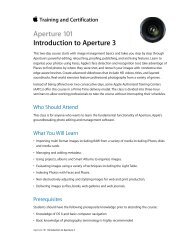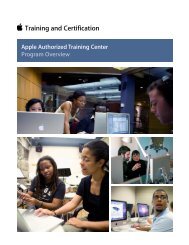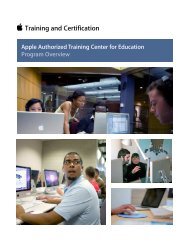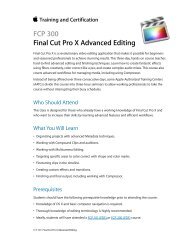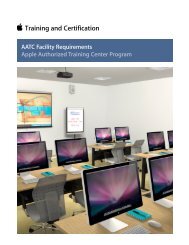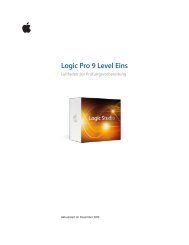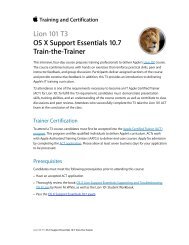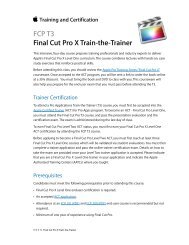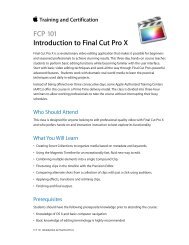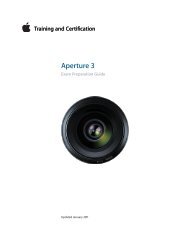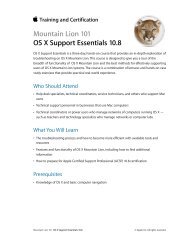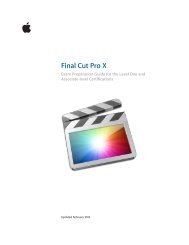OS X Support Essentials 10.8 - Training - Apple
OS X Support Essentials 10.8 - Training - Apple
OS X Support Essentials 10.8 - Training - Apple
Create successful ePaper yourself
Turn your PDF publications into a flip-book with our unique Google optimized e-Paper software.
<strong>OS</strong> X <strong>Support</strong> <strong>Essentials</strong> <strong>10.8</strong> Exam Preparation Guide<br />
• Describe how power failures and force ejecting a disk can corrupt a<br />
volume.<br />
• Identify three ways to unmount a disk from the Finder in <strong>OS</strong> X.<br />
• Describe Target Disk Mode.<br />
• Given a Mac with <strong>OS</strong> X installed, manage file ownership and<br />
permissions.<br />
• Describe how the Get Info window in the Finder can be used to<br />
manage permissions for files and folders.<br />
• Describe how Disk Utility can be used to repair permissions for files<br />
and folders.<br />
• Describe the function of each of the permission settings and ACL<br />
settings on <strong>OS</strong> X files and folder.<br />
• Given a Mac with <strong>OS</strong> X installed, identify the owner and group for any<br />
file.<br />
• Use the Get Info command in the Finder.<br />
• Identify the owner and group permission settings for users’ home<br />
folders in <strong>OS</strong> X.<br />
• Describe why the root of any user’s home folder in <strong>OS</strong> X is accessible<br />
to other users.<br />
• Describe the permissions settings on the Shared folder in <strong>OS</strong> X that<br />
allow it to act as a shared storage location for local user accounts.<br />
• Describe what it means to “ignore volume ownership,” including when<br />
it’s useful to do so, and one potential risk when ignoring ownership.<br />
• Describe how anyone can access any file on the drive while ownership<br />
is ignored.<br />
• Describe how the organization of the <strong>OS</strong> X file system allows multiple<br />
users to safely share local files and folders.<br />
• Define the term “sticky bit” as it applies to the <strong>OS</strong> X file system.<br />
Lesson Ten review questions<br />
After completing Lesson Ten, you should be able to answer the following<br />
questions.<br />
1. What is the difference between disks, partitions, and<br />
volumes?<br />
2. What are the two primary partition schemes for Macformatted<br />
disks? What are their differences?<br />
3. What two volume formats are supported for an <strong>OS</strong> X system<br />
volume?<br />
4. How does file system journaling work?<br />
5. What are the four erase options available in Disk Utility? What<br />
are the differences between them?<br />
6. How does the Secure Empty Trash feature work in the Finder?<br />
17



